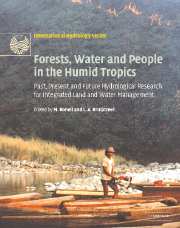 Forests, Water and People in the Humid Tropics
Forests, Water and People in the Humid Tropics Book contents
- Frontmatter
- Contents
- List of contributors
- Foreword
- Preface
- Acknowledgements
- Symposium and Workshop
- Introduction
- Part I Current trends and perspectives on people–land use–water issues
- Part II Hydrological processes in undisturbed forests
- Part III Forest disturbance, conversion and recovery
- Part IV New methods for evaluating effects of land-use change
- 27 Remote sensing tools in tropical forest hydrology: new sensors
- 28 Detecting change in river flow series
- 29 How to choose an appropriate catchment model
- 30 The disaggregation of monthly streamflow for ungauged sub-catchments of a gauged irrigated catchment in northern Thailand
- 31 Parsimonious spatial representation of tropical soils within dynamic rainfall—runoff models
- 32 Isotope tracers in catchment hydrology in the humid tropics
- 33 Process-based erosion modelling: promises and progress
- 34 Impacts of forest conversion on the ecology of streams in the humid tropics
- Part V Critical appraisals of best management practices
- Conclusion: Forests, water and people in the humid tropics: an emerging view
- Plate section
- References
32 - Isotope tracers in catchment hydrology in the humid tropics
from Part IV - New methods for evaluating effects of land-use change
Published online by Cambridge University Press: 12 January 2010
- Frontmatter
- Contents
- List of contributors
- Foreword
- Preface
- Acknowledgements
- Symposium and Workshop
- Introduction
- Part I Current trends and perspectives on people–land use–water issues
- Part II Hydrological processes in undisturbed forests
- Part III Forest disturbance, conversion and recovery
- Part IV New methods for evaluating effects of land-use change
- 27 Remote sensing tools in tropical forest hydrology: new sensors
- 28 Detecting change in river flow series
- 29 How to choose an appropriate catchment model
- 30 The disaggregation of monthly streamflow for ungauged sub-catchments of a gauged irrigated catchment in northern Thailand
- 31 Parsimonious spatial representation of tropical soils within dynamic rainfall—runoff models
- 32 Isotope tracers in catchment hydrology in the humid tropics
- 33 Process-based erosion modelling: promises and progress
- 34 Impacts of forest conversion on the ecology of streams in the humid tropics
- Part V Critical appraisals of best management practices
- Conclusion: Forests, water and people in the humid tropics: an emerging view
- Plate section
- References
Summary
INTRODUCTION
Isotope tracers are an important tool for quantifying the age, origin and pathway of water to streams in headwater catchments. While used regularly in temperate and high latitude areas, applications of isotope tracer techniques in the humid tropics have been minimal to date. In the developing world, finances and logistics often preclude the use of traditional hydrometric measures of streamflow, groundwater dynamics and soil water recharge. Thus, isotopic tracers and isotopic hydrograph separations (IHSs) can serve as a valuable tool for extending our understanding of streamflow generation in poorly gauged areas (Shuttleworth, 2002), particularly in humid low latitude regions. They can also provide complementary information on water sources and pathways that are often required in order to draw conclusions about streamflow generation (reviewed by Bonell, this volume), effects of disturbance on tropical forest ecosystems (Bruijnzeel, 1990), or the closure of nutrient cycles in tropical forest ecosystems (Elsenbeer et al., 1995).
The aim of this chapter is to provide an overview of what has been accomplished in isotope tracing studies (mainly in mid-latitude environments to date) as an impetus for those working in the humid tropics to consider the merits of this approach. While we do not advocate use of this technique exclusively in research settings, we argue that it can be a valuable approach in the ‘toolkit’ of land managers and catchment scientists working on hydrological processes related to land use change in humid tropical areas.
- Type
- Chapter
- Information
- Forests, Water and People in the Humid TropicsPast, Present and Future Hydrological Research for Integrated Land and Water Management, pp. 770 - 789Publisher: Cambridge University PressPrint publication year: 2005
References
- 10
- Cited by


